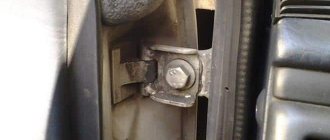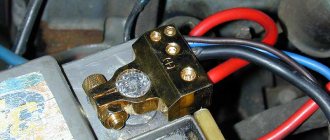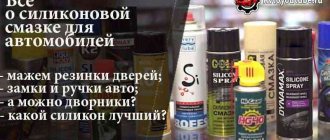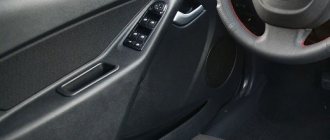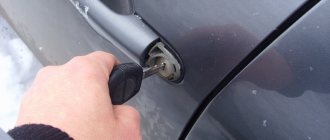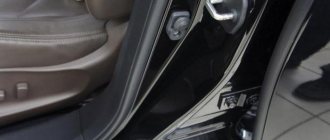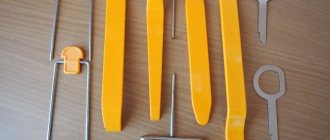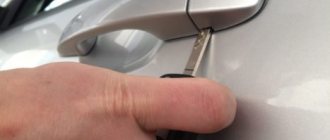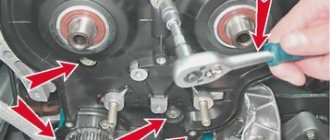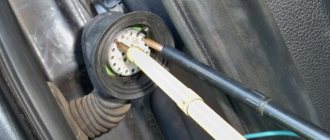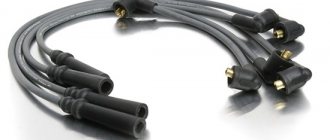Taking into account the fact that the car is operated in an aggressive environment, corrosion, oxidation, destruction of rubber seals, etc. are inevitable over time. Also, quite often on cars even with low mileage, creaking doors appear.
So, the problem of squeaking hinges on car doors is quite relevant. The fact is that on the specified elements, coated with lubricant for protection and softness of operation, the specified lubricant tends to work, dry out, wash off, etc.
In other words, there is a need to lubricate the door hinges. It would seem that everything is simple, but not all owners know which lubricant is suitable for door hinges, how to lubricate the hinges and what needs to be taken into account when selecting a lubricant. Let's figure it out.
What is required from a lubricant?
Before you lubricate your car door locks for the winter, you need to understand that this is a complex structure that works in extreme conditions. Therefore, the lubricant must meet increased requirements:
- Withstand low temperatures.
- Successfully resist corrosion.
- Low coefficient of friction.
- Resist washing off, not only with water, but also with alkaline and saline solutions.
- Have a long validity period.
In order not to think about how to defrost the lock cylinder, it is better to take care of its prevention in advance. Of course, motor oil will not help here, just like sunflower oil.
Limiter device
The limiter is quite simple. There is a rod, on one side it is rigidly attached to the body panel, on the other - to the door, inside of which it runs along a special opening. The opening is equipped with plastic bushings. The rod is equipped with one or more protrusions necessary for fixing the door in various positions. For example, so that it does not slam shut from strong winds.
It is not surprising that a rod made of metal quickly wears out plastic bushings. To avoid this, you should regularly apply a certain lubricant to moving parts. Its deficiency or absence results in creaking when opening the car.
Why lubricate car door hinges?
Compared to ordinary home doors, car doors experience significantly greater loads. At the same time, the driver's door opens much more often than the others, so it starts to creak first.
Creaking is not only unpleasant, but also dangerous. An unusual sound indicates increased friction in the hinge, which accelerates its wear. The door first creaks, then closes poorly, sags and eventually requires repair.
It is necessary to lubricate the hinges not only to get rid of squeaking or prevent it, but also to ensure easy and smooth operation of the door mechanism.
Sometimes creaking or extraneous noise does not come from the hinges, but from the rubber seals that secure the doors to the car body. If the seals are damaged, they should be replaced - then the unpleasant sounds will disappear.
In some cases, lubricating the hinges alone is not enough. If inspection of the parts reveals traces of severe corrosion, cracks, or destruction of fasteners, then most likely the hinges will need to be replaced.
Types of lubricants and their characteristics
The modern driver does not need to use improvised means to process car doors and turn to professional workshops for this. The automotive chemicals market can offer a suitable product that will be suitable in cost and meet the user’s requirements. You need to understand automotive lubricants to make the right choice.
The lubricant contains additives, thickeners, oils and additional components that can expand the range of qualities and characteristics of the original substance. Lubricant for automobile hinges is divided into subtypes as follows:
- By composition (liquid, which is called oil, semi-solid with a plastic structure, solid).
- By method of use (universal or general purpose, motor, transmission).
- According to the nature of the raw materials used and the substance that forms the basis (mineral, vegetable, synthetic and semi-synthetic).
Litol lubricant is a general purpose product
Regardless of which lubricant you choose, it must have a certain set of characteristics:
- viscous structure;
- strength;
- resistance to high and low temperatures;
- good lubricity;
- stability of preservation of physical and chemical properties;
- resistance to mechanical stress;
- water-repellent properties;
- protection against wear and corrosion.
Choosing a lubricant
If we lived in an ideal world, then all lubricants for car doors, hinges and locks would have all the advantages and characteristics described. In reality, there are many manufacturers who allow themselves to produce low quality products.
We have selected the most successful brands of car lubricants from all existing options. Remember that each lubricant must be applied to well-cleaned surfaces.
Even if the hinges and locks in the car are covered with a layer of old grease, but there are traces of dust on it, they still need to be cleaned and re-lubricated.
You will need to apply a lubricating grease to the cleaned hinges of the door mechanism. A good alternative are car care products such as Litol and Solidol.
A worthy response from Russian manufacturers to foreign companies that offer more expensive products. Grease is applied only to those door elements that frequently experience friction.
At this point, the preparatory work can be considered completed and proceed to the next stages of processing car doors.
Making the right choice for lock processing
The Molikot Multigliss lubricant is worthy of attention. This tool can be used for all cars without a single exception. All the features we looked at are present in this product. The manufacturer considered it necessary to add resistance to weather changes, which are considered normal in Russia.
To treat hinges, it is convenient to use Liqui Moly spray, which is easy to apply, penetrates deeply and lubricates all hidden surfaces. The lubricant is available in the form of a spray, which creates additional convenience for the car user. Many drivers remain faithful to the old WD-40, which can provide decent care for your car's hinges and locks.
You can safely choose white lithium-based grease SP5545 Step up. Locks with this treatment will work well even with intensive use.
If you do not want to carry out the lubrication procedure frequently, and want to drive a car with properly functioning doors all winter, then it is recommended to use the HG5501 substance with heat-resistant characteristics and the addition of silicone.
This product can be applied to plastic, metal and rubber. Such a universal invention.
Making the right choice for processing loops
The hinges in the machine need to be lubricated several times a quarter; if the operation is not particularly intensive, the frequency of this procedure can be reduced. But is it worth it to start the state of the doors and wait until they cry out to you by creaking and jamming when the car is opened.
To avoid regretting your choice, buy Wurth 2000 synthetic adhesive lubricant. It is also suitable for locks, cables, rollers and gears.
Good penetration into all gaps and crevices, formation of a stable and reliable film, protection from all those factors that negatively affect car parts - all this allows us to call this product the best in its segment.
A similar product that can also be used on door locks, not just hinges, is Molykote Multigliss.
Since you are treating doors, you should at the same time acquire a Movil spray can, which is very effective at treating the lower edge, preventing the formation of corrosion. Hinges can also be treated with this product, but only if there is no special lubricant at hand.
The thick brown liquid, when properly applied to well-cleaned surfaces, can retain its protective and lubricating functions for about a year. And this at a low cost. The only small drawback is the process of applying this product, which requires a brush.
You need to love, protect and take care of your car, then it will respond to you with gratitude and will not let you down along the way. Each element of the machine requires your attention, door hinges and locks can cause inconvenience if they are not monitored and the lubrication process is ignored.
How to apply
The method of applying lubricant to hinges and door locks depends on the product chosen. If you have settled on nigrol, then you cannot do without a medical syringe. The needle is removed from the syringe, nigrol is drawn into it, and then carefully poured into special hinged caps. Do not overdo it - excess lubricant will flow down, staining the threshold.
Thick coatings are usually applied with brushes, and if you choose soap, then you can simply rub the rubbing mechanisms with its corner. At the same time, open/close the door so that the product penetrates deeper inside. You should not make a soap solution and then pour it into the hinges - such a lubricant will only help for a short time.
The easiest way to work is with sprays - they create an oily film on the parts, eliminating squeaking. It is necessary to spray the substance from the can at a distance directly onto the communicating elements, while closing/opening the door several times for better penetration of the spray.
Before processing, wipe the rod with a paper napkin or dry rag to remove old grease and various debris.
How to lubricate car door locks for the winter?
Finding the right lubricant for car door locks leaves many vehicle owners with a difficult choice. After all, there is a huge range of different products on sale from different manufacturers. How not to make a mistake and purchase a quality product?
Modern lubricants have different chemical compositions. However, from all the variety, several of the most effective options can be identified:
- Silicone;
- Graphite;
- Lithium.
In addition, they can have different shapes and be used as:
- Spray;
- Aerosol;
- Or have solid formulations.
Below we will examine each type of lubricant in more detail.
Silicone lubricants
The silicone base of the lubricant perfectly resists moisture, retains its properties for a long time and does not change them even with strong temperature changes. Also, a lubricant based on this base is compatible with rubber, metal and plastic. When applied, it forms a polymer protection in the form of a film.
There are several forms of manufactured product for locks and other mechanisms:
- In liquid form;
- Gel;
- Aerosol.
Each of the listed forms has its own purpose. For example, an aerosol can is suitable for treating door locks. It comes complete with a tube for treating hard-to-reach areas.
Only one disadvantage of this product has been identified:
- When the spray hits the surface near the treated area, oily traces remain. If they are not removed immediately, stains will remain.
Before using the product, remember that silicone grease can most often only be applied to a dry, clean surface. Before use, you should clarify this point in the instructions for using the lubricant.
Graphite lubricants
Graphite grease is made from mineral or synthetic thickened oil and graphite powder. The oil base of the lubricant effectively repels water. This product protects parts from corrosion and can withstand temperatures from -20 to +70 °C.
Why not LITOL, SOLIDOL, WD-40 and SILICONE
All these products are not suitable for door mechanisms, as they reduce friction. The squeak will disappear, but another problem will appear. When using silicone, lithol, grease or WD-40, the door will swing open or slam shut due to gusts of wind, as it will not be able to stay in the special grooves.
In addition, the listed lubricants “love” to stick a lot of debris on themselves - sand, dirt, dust. Subsequently, this debris behaves like an abrasive - it causes strong friction between parts, which leads to rapid wear of the plastic inserts.
Known to every driver, WD-40 is an excellent solvent. It has proven to work well as a lubricant, but can quickly corrode seals.
Popular means
EFELE UNI-M Spray
A universal composition, which is a dispersion of solid lubricating components in mineral oil.
The high anti-wear properties of EFELE UNI-M Spray are due to the combined action of liquid and solid lubricants.
The dispersion contains corrosion inhibitors, and therefore prevents the appearance of rust on car locks and hinges. The lubricant has high penetrating properties and effectively displaces moisture.
Liqui Moly Wartungs-Spray Weiss
Aerosol composition of white color containing microceramic particles. It has good lubricating and water-repellent properties, protects parts from frictional wear and corrosion.
The spray is intended for locks, hinges and other moving mechanisms of cars. The operating temperature range of the lubricant is -30 to +250 C.
Wurth HHS 2000
Aerosol lubricant with increased penetrating properties, excellent adhesion and the ability to harden in a short period of time. Contains synthetic oil, is resistant to washing off with water and high pressure, works at temperatures from -35 to +180 C.
The main disadvantage of the material is its high cost.
Permatex 80075
Colorless composition with a high content of active ingredients. When applied, it turns into foam that penetrates into the most difficult to reach places.
The lubricant was originally intended for chains of motorcycles, bicycles and garden equipment, but experience in its use allowed us to expand this list to include hinges and locks.
The product simultaneously cleans, lubricates and protects parts from corrosion, and prevents dirt and sand from adhering to them.
CRC Multilube
Waterproof universal lubricant spray for hinges. The product contains high-quality mineral and synthetic oils, antioxidant and antifriction additives, and friction modifiers.
The material easily penetrates the friction surfaces of the hinge joints and forms a strong protective film on them. To better control the application process, the lubricant has a bluish tint, which completely disappears after a few days.
Lubricants for car door locks
Now let's look at the most popular means for processing locks, their cylinders and mechanisms. On the Internet you can find many conflicting reviews about this or that product. We tried to be objective and collected information for you about lubricants that are really effective even in severe frost conditions . It is also worth mentioning that most of the products listed below can be successfully used to treat not only locks and their cylinders, but also door hinges.
Also, when treating the lock, pour the products listed below not only into the cylinder, but also treat the mechanisms directly with them. This can be done with or without removing the lock. It all depends on the design of the particular car. For example, it is better to remove the locks of domestic VAZs completely and lubricate the rubbing parts. And in foreign cars, where dismantling is complicated by the design, you can lubricate only the accessible parts of the lock.
Molykote Liquid Grease G 4500
Molykote Liquid Grease G 4500
This is one of the most popular means for lubricating car door lock cylinders. Its operating temperature range is -40°С…+150°С. The lubricant is absolutely harmless to humans and does not emit harmful substances into the atmosphere. In addition, it is compatible with metals, plastics, rubber and various chemical compounds found in the machine body. The manufacturer claims a 3-month warranty for use even in difficult operating conditions. The most popular package size is 400 ml (although there are packages of 5 kg or more). The approximate cost of such a tube in Moscow at the end of 2022 is 2050 rubles.
Lubricant characteristics:
- base oil - polyalphaolefin;
- thickener—a thickener based on an aluminum complex;
- operating temperature range - -40°С…+150°С;
- critical load (Timken method) - more than 177 N;
- starting moment at a temperature of -40°C - 0.9 Nm.
This tube will last you for several seasons depending on the intensity of use.
Step Up SP5539
Previously, this lubricant was offered under the article number SP 5545 (312 g), and now it is produced under the number SP 5539. The temperature range of this lubricant is even wider - -50°C...+220°C. Sold in aerosol cans weighing 284 g. The product is suitable not only for lubricating car door locks, but also for its other parts. After all, since the lubricant is based on casting, it can be used to treat plastic and rubber surfaces to protect them from moisture and destruction.
The lubricant contains the original WetOut composition, which creates a water-repellent film on the treated surface. It will help extend the life of not only the iron parts of the lock, but also the rubber seals and plastic trim parts. The price of a tube weighing 312 grams is 520 rubles in Moscow as of the end of 2022.
HI-GEAR HG5501
The lubricant is also silicone-based. When applied to a work surface, it forms a thin but durable polymer material that reliably protects it from moisture. In fact, the lubricant is universal, so in addition to cars, it can be used in other equipment - with household door locks, rubber and plastic surfaces, drive cables and much more. It is also possible to use the product in everyday life with products made from the listed materials.
The container capacity is 283 ml. The kit includes a plastic tube that can be connected to the sprayer and apply lubricant to hard-to-reach places. The price of a cylinder is about 520 rubles as of the end of 2022.
Wurth HHS-2000
Wurth HHS-2000 grease
Wurth HHS-2000 08931061 lubricant is extremely popular among car enthusiasts in our country. According to the instructions, it is intended for lubricating parts under high pressure and loads. Like the previous product for lubricating car door locks, it is universal. Its features include:
- High penetrating ability and short thickening time. It can be used to lubricate car door locks. Using a tube, it is placed inside the lock, where it almost immediately becomes thick, forming a protective film on the surface of the parts and simultaneously displacing moisture. The composition of the product provides a high lubricating effect.
- High adhesion. That is, the ability to adhere to the surface being treated. During processing, the liquid fraction evaporates, leaving only direct lubricants in the work.
- High pressure resistance. Wurth HHS-2000 grease has a long service life even under conditions of high loads and pressures.
- The product prevents sticking of metal surfaces and also reduces screwing resistance.
Prevention methods
To prevent your car door from creaking when opening, regularly lubricate the stops and hinges with a suitable product. Don’t be lazy - buy a 25 ml syringe at the pharmacy and treat the mechanisms at least once a year. Also, do not leave the car wash without drying your car for 5-10 minutes. Open/close the doors as you go, helping excess moisture escape.
In winter, it is better to use spray lubricants to treat locks and hinges, and coat rubber seals with silicone. Do not start the problem - at the first appearance of a squeak, lubricate the mechanisms. This way you will save your nerves and protect rubbing parts from rapid wear.
What to do if the car door lock is frozen?
Freezing of the lock in cold weather is a normal phenomenon and a common situation among those who did not take care to lubricate the door keyhole in advance.
Often the door lock freezes after washing. Moisture that gets into the locking mechanism freezes. As a result, there is a problem with opening the car door.
There are two ways out of this situation:
How not to open a frozen lock:
- Never heat the lock with fire, the handles are made of plastic, you will only make things worse.
- Do not pour on the castle ; in frosty conditions your situation will worsen, and the water will freeze eventually anyway. In addition, the paint and varnish of the car will be damaged due to sudden temperature changes.
Where does the squeak come from?
The creaking sounds of car doors opening are a consequence of metal elements rubbing against each other. Door lock pins become clogged:
- road dirt;
- dust;
- sand;
- reagents;
- moisture.
This gradually corrodes and dries out the factory lubricant. The lack of lubricant leads to corrosion on the mechanisms - the door begins to creak.
Old pins also cause unpleasant sounds. They can no longer cope with the assigned load, so the car doors sag, causing a grinding noise due to metal parts rubbing against each other. After installing the new mechanisms, the creaking is not heard.
A car door will squeak if its lock is not set correctly. Many drivers in this situation make the mistake of lubricating or filling the hinges with locks using whatever comes to hand. This “treatment” of mechanisms has a short-term effect - soon the creaking of the car door returns.
Frequently asked questions and answers
Why can't you heat the castle with boiling water? I don't see any harm. Answer: hot water can damage the coating of your car due to a sharp temperature change, and also, after the boiling water cools down, it will freeze again, but this time more strongly, since you deliberately poured it there yourself. It will also cause corrosion of the locking mechanism during warming, and then you will definitely have to change the locks.
What about the exhaust method? Answer: Exhaust gases are equivalent to breathing, the effect may be there, but the larva will also quickly “seize” again after it.
I tried to clear the lock with a pocketknife, since I didn’t have anything else at hand. The mechanism broke and had to be replaced. How to carry out prevention in winter so that this definitely doesn’t happen again? Answer: Initially, your idea of such “cleaning” was a failure, since you drove the ice even deeper. Drive the car into a warm box for at least a few hours so that it thaws, clear all the snow from all doors and seals, then wipe it dry. Treat keyholes and seals with moisture-displacing silicone or graphite grease. If your car is on the street, purchase a car cover and cover your car with it. Clean the doors periodically with a brush and you will be happy.
I used the defrost - it didn't help. Are there any analogues to this remedy? Answer: You may have received a low-quality or expired cylinder. If you did everything according to the instructions, then there should be no problems. Let us remind you: inject the product directly into the lock cylinder, wait a while, if it does not help, repeat the procedure. Usually the lock opens the first or second time.
Is it possible to use anti-freeze if there is nothing else at hand? Answer: It is possible, but it is not advisable. Since it is alcohol-based, but do not forget that it contains water.
Dashboard
This is the most problematic area of most used cars. To understand where exactly the “play” is, you need to try pressing the plastic panels one by one while driving and listen to see if the sound has disappeared (therefore, it is better if there is an assistant in the car). You can also try to insert an unnecessary plastic card into the cracks that cause the most suspicion. If the grinding noise has disappeared, then the “cricket” has been found. All that's left is to get rid of him.
Healthy! To determine exactly at which joint the unpleasant sound occurs, it is enough to inspect the surfaces. As a rule, abrasions appear in such places.
There are two options for how to do this - simpler and more complicated:
- We completely dismantle the dashboard and put Modelin (one sheet of sound insulation will cost 760 rubles), Bitoplast (a sheet will cost 250 rubles) or so-called mushrooms (plates with small “outgrowths” that make the joints even tighter) into the joints. Particular attention should be paid to the panel's hinged elements (glove box lid, fuse box, clock, etc.).
We recommend: Why and how often to refill your air conditioner. How risky is it to do such a procedure yourself?
Healthy! Some people glue the joints with special tape or regular adhesive tape from the pharmacy.
- Pour silicone grease into the cracks (a can of WD-40 with a spout will cost about 250 rubles) and wipe off the excess with a napkin.
Silicone grease is the fastest and cheaper option. But you shouldn’t expect it to work for a long time, so the procedure will have to be repeated periodically. Fortunately, this composition is not conductive, so you don’t have to worry about “shorting” the dashboard.
Healthy! If the dashboard of a car consists of many parts (such as in the Chevrolet Lacetti), which are attached with self-tapping screws, then one disassembly is enough for extraneous sounds to begin to appear in the car. If this element is a monolith (as in Renault Logan), then even a used car will not have problems with “crickets” in this area.
What properties should a lubricant for car locks have?
First of all, the lubricant must form a film that protects the inside of the lock from moisture and have water-repellent properties. It should not be washed off with water!
In addition, the composition must withstand exposure to solutions with an alkaline, acid and salt base. Car owners living in big cities know better than anyone else what chemicals public utilities sprinkle on their roads. And what harm do they cause to automobile mechanisms?
A high-quality lubricant should withstand sub-zero temperatures well. And also retain their properties for a long period of time (at least a season, or even two). Possessing such properties, the lubricant reduces the possibility of corrosion on the metal surface of the locking parts.
Also, the lubricant must be a homogeneous mass. Any change in consistency should alert the buyer. After all, even small lumps of unknown origin present in the lubricant can independently clog the larva of the mechanism.
Alternatives
To prevent car doors from freezing, you can use special water-repellent compounds that do not contain hazardous components. This lubricant is produced by several companies - for example, TurtleWax, Wynn's and others. It contains a small amount of technical silicone, as well as polyesters and other organic components, which are included in the composition to create a durable film on the surface of the seal that retains its elasticity for a long time. Applying the composition to car door rubber bands is very simple, since it comes in the form of a spray.
There are also exotic products that also help combat door freezing. For example, in the Far North and other cold regions, bear or deer fat is used to prevent restriction of access to the car interior. Such products effectively cope with freezing, but are rarely found on sale and allow you to get the effect for only 1-2 days.
When to treat
It is better to lubricate door hardware before the onset of cold weather. In winter, many coatings thicken. It is recommended to process not only the hinges, but also the locks on the doors, including the trunk. To remove ice from storm drains and seals, apply silicone grease.
After this treatment, the doors will not freeze throughout the winter. To lubricate locks, use WD-40 - apply the product through the key hole, slightly prying it. After this, the locking mechanism key is opened/closed several times in a row. This way the lubricant envelops the surfaces of all contacting elements inside.
A similar treatment of parts occurs after each car wash, especially in winter. Even thorough wiping with a rag will not be able to remove all the moisture from the rubber bands - after a couple of hours, the smallest drops will turn into ice.
How to treat rubber car door seals
The seals protect against dust and dirt from penetrating into the interior. At negative temperatures, rubber can lose its properties, becoming hard. The water that gets on the seals freezes, gradually destroying them. And besides, they can freeze to the metal of the body, which will cause certain difficulties in opening the door.
how to lubricate car door locks in winter . Regarding rubber seals, we recommend lubricating them with a special frost-resistant silicone grease before the air temperature drops below zero.
It will form a thin silicone film that will repel water and prevent the destruction of rubber seals. In addition, it protects the door from freezing.
The disadvantage of polymer lubricant is that it is washed out under running water in the sink, especially if it is a cheap and economical option. The best option would be to use a mineral lubricant that has a longer lasting effect and is resistant to washing off.
